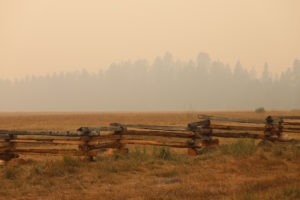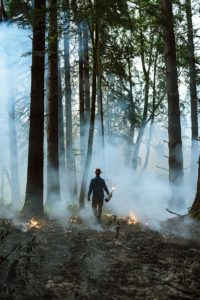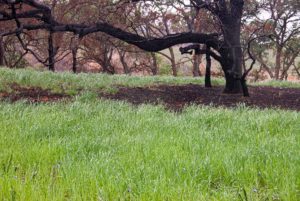With an ongoing drought, fire season is most definitely upon us here in the Bay Area. For 64 years, Smokey Bear (also known as Smokey the Bear) has admonished us that only we can prevent forest fires. Now we are beginning to understand that Smokey’s interpretation of fire in the California landscape is perhaps too simplistic.
Among other things, we have learned that many plants in California’s drier landscapes have evolved traits that allow them to regenerate after a fire. A landscape seemingly devoid of life after a fire bursts into bud and bloom with the rains, and the once-blackened landscape is carpeted with green shoots growing from charred stumps or with the colorful blossoms of annual wildflowers in the spring.
Some plants store energy in their roots for recovery and regrowth after a fire. Some of these can resprout from above-ground parts that were damaged but not killed. Others, well-known in California’s chaparral plant communities, resprout after fire from basal burls, also known as “lignotubers,” that contain dormant buds and food reserves. Chamise and a number of species of manzanita are adapted to resprout from lignotubers after fire.
Yet other shrubs, perennials, and annual plants are killed outright by fire. But over the years, they have accumulated long-lived seed in the soil (also known as their “seed bank”), and some of those seeds are stimulated by fire to germinate and grow. In some cases, it is the heat of the fire that breaks down or cracks an impervious seed coat, allowing the seed to take up water and grow when the rains start. In other cases, smoke or charred wood produces a biochemical effect on the seed that facilitates germination. The seeds of most manzanitas and many ceanothus species require fire to germinate, as do those of a number of the wildflower species that produce spectacular spring displays following a fire.
Some cone-bearing trees also require fire to reproduce from seed. Their cones remain tightly closed on the tree for years–sometimes for the life of the tree–unless they are stimulated by the heat of a fire to slowly open and release their seeds. Thousands of Bishop pine cones at Point Reyes opened in the Vision fire of 1995 and created a carpet of seedling trees the following year.
But as necessary as fire is to the regeneration of some plants in California, it is important to know that every fire is different, and these plants are adapted not to fire in general, but to a particular fire regime, or pattern of fire. The frequency, intensity, and season in which fire occurs in an ecosystem are critical to the survival of the plants and seeds, and we’re still learning how we can best manage wildfire in our native ecosystems.

.jpg)



